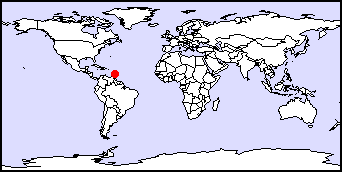Town/City:
|
Bridgetown
|
State/Province:
|
St. Michael
|
Country:
|
Barbados
|
Latitude/Longitude:
|
N013-06.2 W059-37.5
|
Information supplied by
Wayne Coutinho
Dated Thu Dec 10 02:41:42 1998 |
Information Topics:
City Description:
Barbados is the most easterly island of the Caribbean. Located approximately
1,930 km (1,200 mi.) southeast of Miami, and although technically in the
Atlantic, it is regarded as a Caribbean territory. Barbados has a total
area of 430 sq. km (166 sq. mi.). With the terrain being generally flat,
it is intensively cultivated for agricultural use. The National Geographic
Atlas of the World Revised, (Sixth Edition, 1995) estimates the population
of Bridgetown at 6,100. The estimated population of Barbados is 262,000,
with a growth rate of 0.24% per year. With more than 600 people per square
kilometer, Barbados is one of the world's most densely populated nations.
The language of Barbados is English, and the literacy rate is 99%. No other
language is in common use, although a local dialect called Bajan is often
used among locals. Barbados presents a largely free enterprise, small,
open economy. Up to the 1970s, that was based primarily on sugar agriculture.
There are now four essential productive industries: tourism, agriculture,
manufacturing, and offshore financial services. There is also an increase
in the information technology industry. A per capita income of $9,200(US)
gives Barbados one of the highest standards of living of all the small
island states of the eastern Caribbean. Barbados has a GDP purchasing power
of US$2.4 billion, an inflation rate of 2% and unemployment rate of 20.5%
(1994 est.). Despite this high unemployment, there is a stable democracy
and a relatively prosperous economy.
Back to Topics
Climate:
Barbados' climate is tropical but due to the steady trade winds, the extremes
of heat are exceptional. It is generally pleasant with a cool, dry period
between December and March. It becomes warmer toward May, with the Hurricane
season following from June to November. It is during the latter part of
this period that the hottest days are experienced. Daytime temperatures
vary according to the month of the year, but are generally between 21-31
degrees C (80-85 degrees F) with a 10 to 15 degree drop during the night.
Average annual rainfall is about 1000mm (40") in coastal areas, reaching
2000mm (80") inland. (Source www.barbados.com)
Back to Topics
Basic Hydrogeology:
Barbados lies directly on the plate boundary and is not a volcanic island.
Barbados was formed by a wedge of sediments that was pushed upward as the
plates moved together. The surface rocks in most of Barbados are the remains
of old coral reefs that grew as the water over this wedge of sediments
became shallow. (Source www.caribbeansupersite.com/region/geology.htm)
The Pleistocene limestone aquifer (PLA) of Barbados is composed of highly
permeable reef limestone overlying Tertiary deep-sea strata that act as
an aquitard. Groundwater infiltrates through the soil and limestone then
flows along the top of the aquitard and into a freshwater lens before discharging
along the coast. Most of the PLA lies well above sea level and the freshwater
lenses only occur in low-lying parts of the island. Average depth-to-water
is 50m and discharge takes place primarily along the coastline. Discrete
recharge takes place through sinkholes, drainage wells and dry valley beds.
Soils influence recharge because of their variable infiltration rates.
Soils occurring at higher elevations are generally more permeable than
those at lower elevations. Thus, there is greater potential for diffuse
recharge through soils at higher elevations. (Fig. 2) (Source www.geo.utexas.edu/jonesi/AWRA1998.htm
and www.geo.utexas.edu/jonesi/gsa1998.htm)
Back to Topics
Water Use:
Bridgetown obtains its main water source from groundwater. The primary
source is the Belle Pumping Station located on the eastern edge of Bridgetown.
(Ian Jones, personal interview)
Back to Topics
Groundwater Issues:
Groundwater is threatened by contamination, leaching of fertilizers, urban
and industrial wastes, and other anthropogenic wastes. Reduction and shortage
in groundwater supplies is also a problem due to high demand of towns,
agriculture, golf courses, and surrounding areas.
Back to Topics
Groundwater Problems:
Reduction in water pressure or slight water shortage can be a problem in
some areas. Illegal solid waste disposal threatens contamination of aquifers.
Elevated nitrate concentrations indicate a widespread anthropogenic impact,
primarily associated with the widespread use of nitrogenous fertilizers
for agriculture (Banner, J. et al., 1994). This might pose a problem
due to the large sizes of sugar plantations and other sources. "However,
nitrate concentrations rarely, if ever, exceed drinking water standards."
(Ian Jones, personal interview)
Back to Topics
Solutions:
At present, there are twelve wastewater treatment facilities in use in
Barbados, ranging in size from 2,860 to 37,400 gpd for hotel facilities
and to 594,000 gpd for the Barbados Water Authority plant. The combined
total treatment capacity amounts to 786,280 gpd. The Barbados Water Authority
plant is a contact stabilization plant located in Bridgetown. Two more
BWA sewerage systems are planned for the south and west coasts, with the
intention of reusing their wastewater effluents. Reuse of treated wastewater
for the irrigation of gardens, plants and lawn grass is limited at present
and there are applications for the reuse of wastewater on golf courses
for a number of major hotels. In addition, plans are in place to reuse
some of the treated effluent from the BWA Bridgetown Sewage Treatment Plant
for flushing sewer lines. (Source www.oas.org/SP/PROG/chap5_6.htm)
Back to Topics
References and Other Author(s):
-
Banner, Jay L.; MaryLynn Musgrove; and R.C. Capo, "Tracing Ground-water
evolution in a Limestone Aquifer using SR Isotopes: Effects of multiple
sources of Dissolved Ions and Mineral-Solution Reactions", In GEOLOGY,
v.22, p.687-690, August 1994.
-
Jones, Ian C. Personal Interview via e-mail, October 11th, 1998.
-
Jones, Ian C. Constraining Recharge to Limestone Island Aquifers.
(www.geo.utexas.edu/jonesi/gsa1998.htm)
-
Jones, Ian C.; Jay L. Banner; and Bwalya J. Mwansa, Geochemical Constraints
on Recharge and Groundwater Evolution: The Pleistocene Aquifer of Barbados.
(www.geo.utexas.edu/jonesi/AWRA1998.htm)
-
Wilson, Mark. Caribbean Region - Caribbean Geology. Teacher of Geography
and Journalism based in Trinidad. (www.caribbeansupersite.com/region/geology.htm)
-
National Geographic Atlas of the World Revised, Sixth Edition, 1995.
-
Barbados General Information. (www.barbados.com)
-
Treatment Wastewater Scheme Reuse in Barbados. (www.oas.org/SP/PROG/chap5_6.htm)
Back to Topics
Contacts:
The University of Texas at Austin
Dept. of Geological Sciences (C1140)
Austin, TX 78712
Telephone: (512) 471-5759 / (512) 371-1500
Ian C. Jones
email jonesi@mail.utexas.edu
Dr. Jay
L. Banner email banner@maestro.geo.texas.edu
Barbados Water Authority
Pine East-West Boulevard
The Pine, St. Michael
Barbados
Dr. John Mwansa, Project Manager
Barbados Water Resources Management and Water Loss Studies.
Telephone: (809) 430-9372 / 430-9373
Fax (809) 430-9374.
Denis Yearwood, General Manager
Telephone: (809) 427-3990/426-4134
Fax: (809) 426-4507
email wrmwls@caribsurf.com
The Caribbean Meteorological Institute (CMI)
Hydrology Section
Husbands, St. James
P.O. Box 130
Bridgetown
Telephone: (809) 425-1362/1365/1367
Fax: (809) 424-4733
Colin A. Depradine, Principal
email cold@inaccs.com
Frank C. Farnum, Chief Hydrologist email fcfarnum@inaccs.com
Back to Topics



